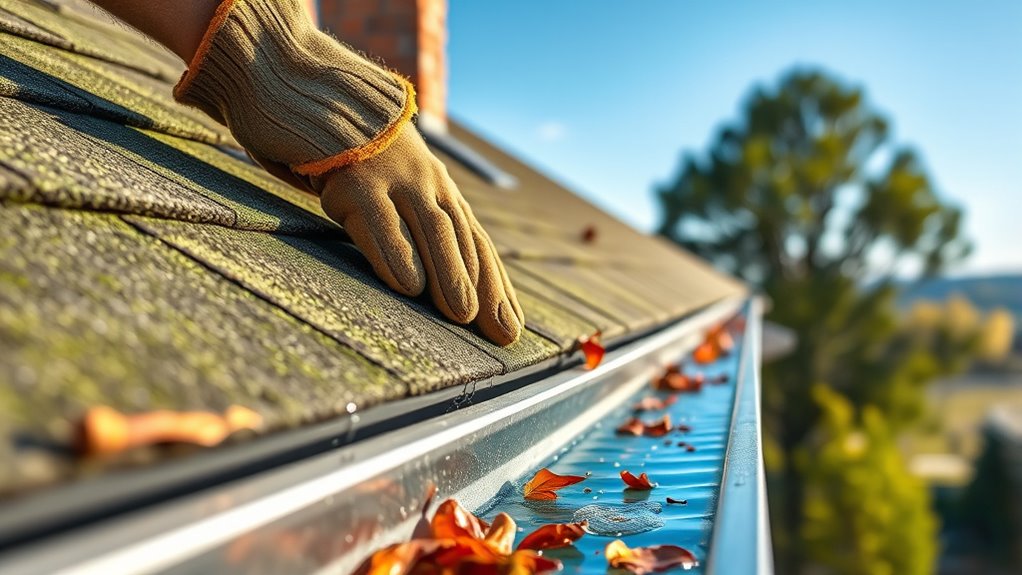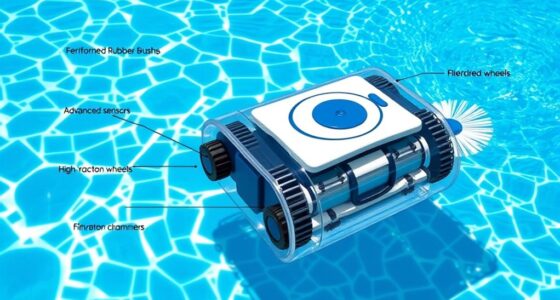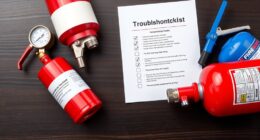To maintain your roof and gutters, inspect your roof twice a year for damaged shingles, leaks, or mold, and keep gutters clear of leaves and debris to prevent water damage. Trim overhanging branches to avoid physical damage, and check flashing, chimneys, and vents for cracks. Regularly remove moss and algae, install protective strips, and schedule professional checkups after storms. If you want detailed tips on keeping your home protected, continue exploring these essential maintenance steps.
Key Takeaways
- Conduct biannual inspections of shingles, attic, and ventilation systems to identify and address issues early.
- Clear gutters twice a year, removing debris and installing screens to ensure proper drainage and prevent organic growth.
- Regularly monitor and replace damaged shingles, ensuring proper alignment and avoiding physical damage from nearby branches.
- Trim overhanging tree limbs to prevent physical damage, debris buildup, and gutter clogging.
- Prevent moss and algae growth with cleaning, installing metal strips, and sealing cracks to protect roof integrity.
Regular Roof and Attic Inspections
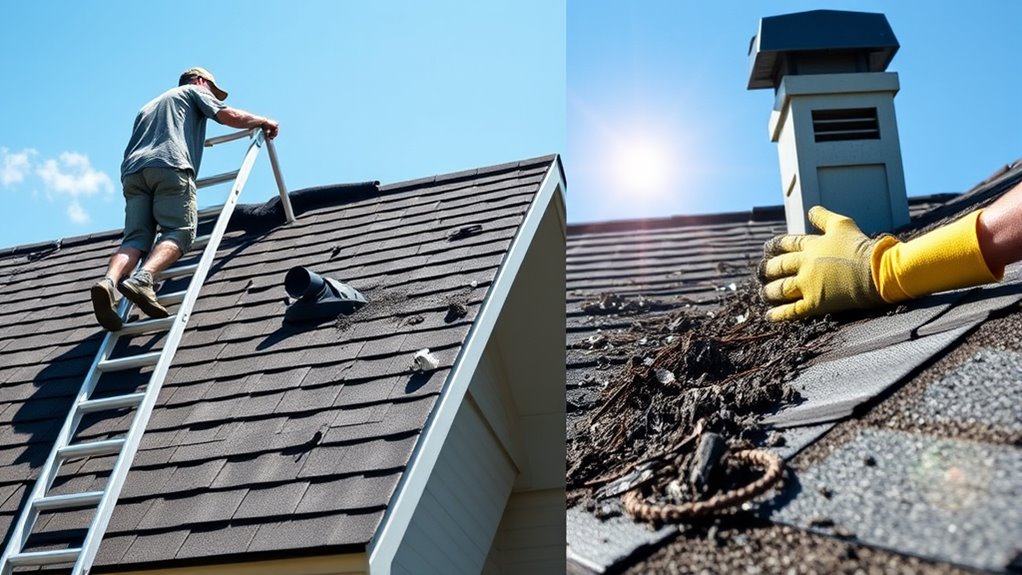
Regular roof and attic inspections are essential for catching damage early and preventing costly repairs. Scheduling at least two inspections each year, in spring and fall, helps identify issues before they worsen.
During a roof inspection, check for missing or damaged shingles, leaks, discoloration, or light shining through. Support hours for professional inspections may vary depending on your location, so plan accordingly. Regularly inspecting your roof can also help you stay aware of potential problems caused by advanced automation technologies, which can sometimes affect roof maintenance schedules.
Attic inspections reveal hidden problems like water stains, mold, or warped roof components that could lead to water damage if left unchecked. Incorporating predictive maintenance can optimize inspection timing and reduce unexpected repairs.
While inspecting, don’t forget gutter maintenance—clean gutters and downspouts to ensure proper drainage and prevent water from pooling on your roof.
Clearing Gutters and Removing Debris

Keeping your gutters clear of debris is key to maintaining a healthy roof and foundation. Regular gutter cleaning, at least twice a year, prevents debris buildup that can cause water backup and damage.
During gutter cleaning, remove leaves, twigs, and organic matter using a soft-bristle brush or garden hose to guarantee proper debris removal. This helps maintain ideal water flow, preventing clogs that could lead to overflowing gutters and water damage.
Installing gutter screens or covers can reduce debris accumulation, making cleaning easier and less frequent. Be sure to work on a stable ladder, preferably on dry, sunny days.
Clearing gutters during fall, when leaves are most prevalent, is especially important for continuous drainage. If you’re unsure or uncomfortable, consider hiring professionals to handle debris removal safely.
Monitoring Shingles and Roof Surface Conditions
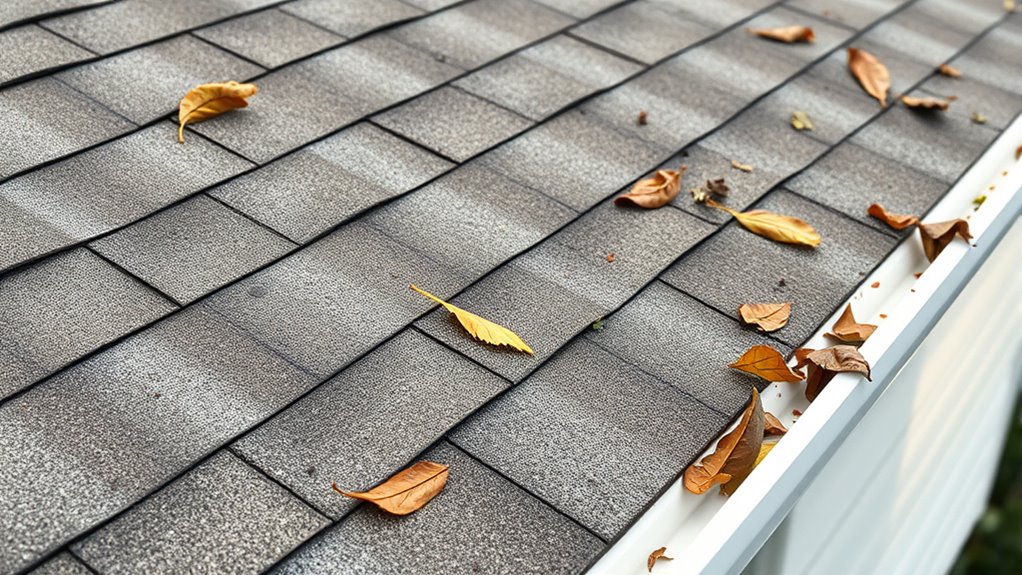
Have you checked your roof lately for signs of damage or wear? Inspect your shingles for curling, cracking, missing, or loose pieces, which can indicate early problems. Look for shingles that sit unevenly or have lifted edges, as these may signal underlying issues like poor sealing or ventilation. Additionally, inspecting for damage from weather can help prevent minor issues from escalating into major repairs. Keep an eye out for discoloration, moss, or algae growth on the roof surface, since these can speed up deterioration if ignored. Regularly monitoring shingle condition allows you to spot issues early and address them before they lead to leaks or structural damage. Damaged or missing shingles should be replaced promptly to prevent water infiltration and avoid further structural damage. Ensure shingles are properly aligned and securely fastened, maintaining your roof’s protective barrier against the elements. Familiarity with common roofing problems can help you identify issues more effectively. Regular monitoring helps catch issues early, saving you time and money on costly repairs later. Additionally, understanding roof maintenance best practices can extend the lifespan of your roof and improve overall safety.
Ensuring Proper Ventilation and Attic Airflow

You need to check that your attic’s ventilation paths are clear and functioning properly. Proper airflow depends on a balance of intake and exhaust vents, so make certain they aren’t blocked by debris or insulation. Keeping vents unobstructed helps prevent moisture buildup and extends the life of your roof. Regularly assessing and maintaining proper ventilation ensures your attic remains well-ventilated and your home protected. Additionally, inspecting for proper airflow optimization can help identify potential issues before they lead to costly repairs. Incorporating innovative materials can further improve ventilation efficiency and durability. Recognizing the importance of ventilation balance can help you effectively manage your home’s airflow system and prevent long-term damage. Being aware of emotional support strategies can also help you manage the stress that comes with home maintenance projects.
Check Ventilation Paths
Ensuring proper attic ventilation starts with inspecting your vents to confirm unobstructed airflow. Check all intake vents, like soffit vents, and exhaust vents, such as ridge or ridge cap vents. Make sure these vents are free of debris, bird nests, or other obstructions that could block airflow.
Clear vents allow cool, fresh air to enter and hot, moist air to escape, maintaining balanced ventilation. Proper airflow prevents attic temperatures from rising excessively during summer, which can speed up shingle deterioration.
Additionally, good ventilation pathways help control humidity and reduce the risk of ice dams in winter. Regularly inspecting and cleaning your vents ensures they work efficiently, promoting a healthy, long-lasting roof and preventing costly damage.
Maintain Proper Airflow
Maintaining proper airflow in your attic requires a balanced system of intake and exhaust vents that work together to promote continuous circulation. Proper ventilation guarantees attic airflow stays consistent, preventing heat buildup that can weaken shingles and damage your roof structure. It also helps control moisture levels, reducing the risk of mold growth and wood rot in roof components. Regularly inspecting and cleaning vents, soffits, and attic spaces keeps airflow unobstructed and functioning efficiently. Incorporating vintage decor elements like antique fixtures or rustic accents can enhance the aesthetic while ensuring the attic remains well-ventilated. Properly designed airflow systems are essential for maintaining consistent ventilation and avoiding common issues caused by poor attic air circulation. When ventilation is adequate, your attic stays cooler in summer and drier in winter, which lowers energy costs and extends your roof’s lifespan. Good ventilation techniques are crucial for optimizing airflow and preventing moisture accumulation, especially in climates with high humidity. Ensuring proper airflow also involves understanding the hours during which different stores operate, as accessing supplies and consultations can be scheduled accordingly, which is especially helpful when planning roof and gutter maintenance. Additionally, understanding energy efficiency principles can help in selecting the right ventilation accessories. Proper airflow is a crucial step in maintaining your roof’s health and preventing costly repairs down the line.
Trimming Overhanging Tree Branches
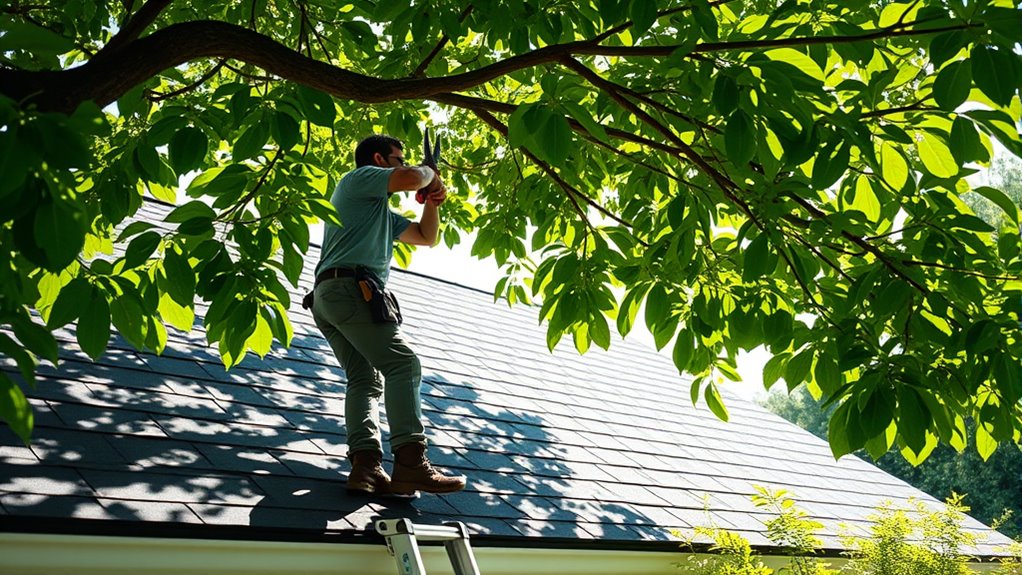
Trimming overhanging branches helps prevent damage to your shingles from rubbing or falling limbs during storms. It also keeps debris like leaves and twigs from clogging your gutters and trapping moisture on your roof. Additionally, regular pruning can improve tree health and reduce the risk of branches breaking unexpectedly. Proper pruning techniques can also encourage air circulation, which helps prevent the growth of mold and rot on your roof. Using the right tools and techniques ensures that you avoid damaging the tree or your property while maintaining safety. Moreover, understanding best soil for string of hearts plants can inspire innovative ways to approach your pruning and maintenance routine, making the process more effective and enjoyable.
Prevent Shingle Damage
Overhanging tree branches can cause significant damage to your shingles if left unchecked. When branches rub against your roof, they wear down the granules, leading to early deterioration. During storms, scraping branches can create small holes, exposing underlayers and increasing water damage risk. Falling leaves and debris from these branches can clog gutters, causing water backup that harms your roof. To prevent this, regularly trim branches to keep them at least 3 feet from your roof surface. This reduces physical damage, minimizes debris accumulation, and protects your shingles. Proper maintenance techniques such as using appropriate tools and trimming at the right time can help maintain the integrity and longevity of your roofing materials. Staying informed about common roofing issues can further aid in maintaining your roof’s health over time.
Reduce Debris Accumulation
Removing overhanging tree branches is essential for reducing debris buildup on your roof and in your gutters. When you trim these limbs, you prevent leaves, twigs, and other debris from clogging your gutters, making gutter maintenance easier and more effective.
Overhanging branches that rub against shingles can also cause damage, leading to premature deterioration. Plus, pruning reduces the risk of storm damage, such as broken branches falling onto your roof, which can be costly to repair.
Keeping branches away from your gutters ensures proper water drainage and helps prevent water damage. Additionally, pruning enhances sunlight exposure, discouraging moss and algae growth.
- Prevents debris buildup
- Protects shingles from damage
- Reduces storm-related risks
- Improves water flow
- Promotes a healthier roof environment
Addressing Moss, Algae, and Organic Growth
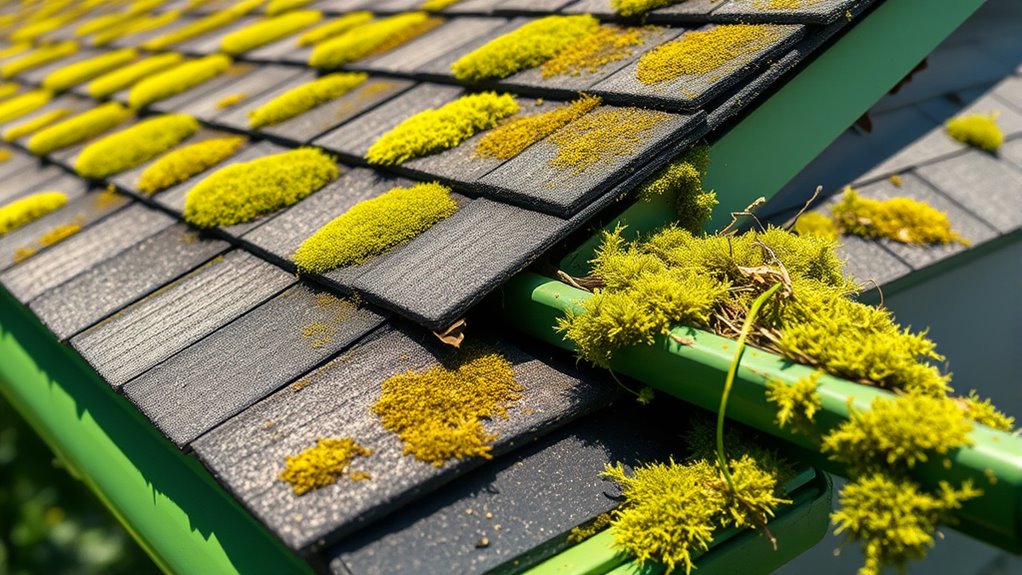
Moss and algae often thrive on roofs that remain shaded and moist, and their presence can considerably speed up roof deterioration. Moss lifts shingles and exposes underlayers, leading to leaks, while algae causes dark streaks that weaken roofing materials. To maintain your roof, regularly apply moss removal solutions and physically remove moss patches. Use tools like a stiff brush or pressure washer on low settings to avoid damage. Installing zinc- or copper-coated strips after cleaning helps inhibit regrowth, prolonging your roof maintenance efforts. Here’s a quick overview:
| Organic Growth | Damage Impact | Prevention Method |
|---|---|---|
| Moss | Lifts shingles, causes leaks | Regular removal, copper strips |
| Algae | Discolors shingles, accelerates decay | Bleach treatments, algae-resistant materials |
| Organic debris | Holds moisture, promotes growth | Routine cleaning, gutter maintenance |
Checking Flashing, Chimneys, and Vents
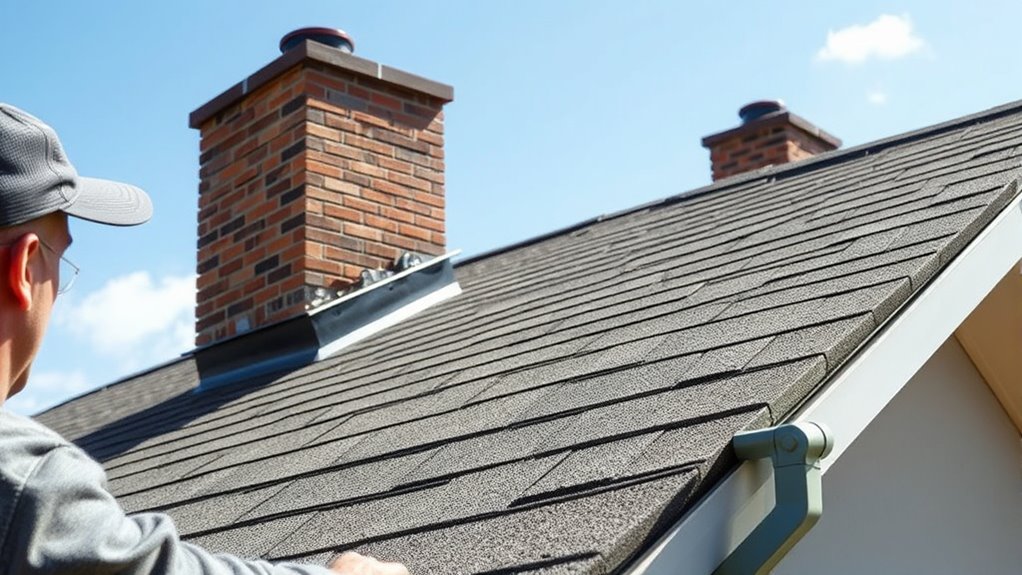
After cleaning your roof and gutters, it’s important to turn your attention to the flashing, chimneys, and vents to prevent leaks and water damage.
Regular inspections from a second-story window can reveal rust, dents, or missing sealant around flashing. Check for cracks, gaps, or deterioration in the sealant and reseal as needed to keep water out.
Examine chimney mortar and bricks for cracks or loose sections and repair promptly to avoid water intrusion.
Ensure vents are free of debris and blockages to allow proper airflow and prevent moisture buildup in the attic.
- Look for rust, dents, or missing sealant on flashing
- Seal cracks or gaps in vent openings
- Repair damaged chimney mortar and bricks
- Clear debris from vents
- Schedule professional inspections after severe weather
Preventing and Managing Ice Dams
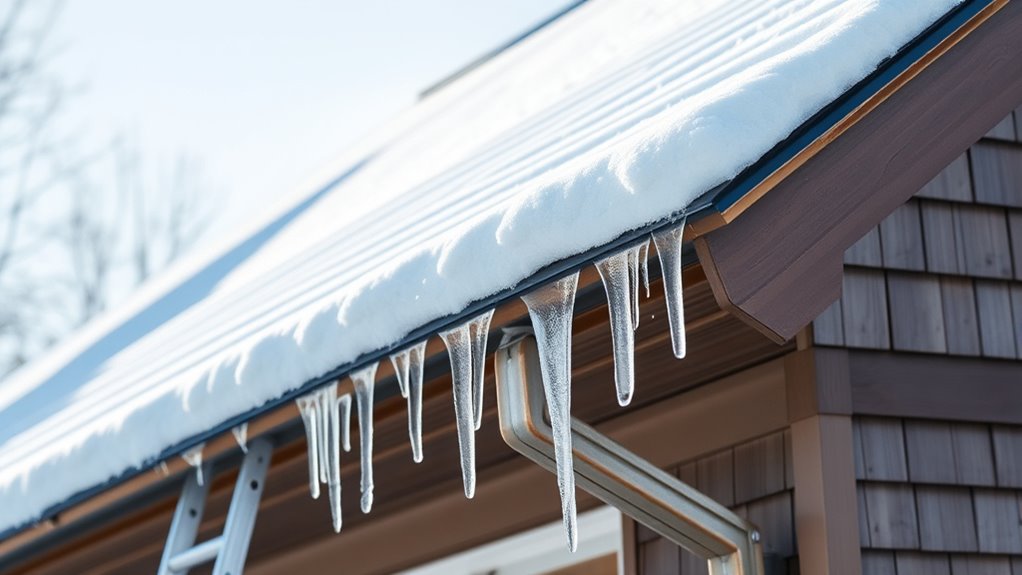
Preventing and managing ice dams starts with understanding how they form and taking proactive steps to minimize their impact. Ice dams develop when melting snow refreezes at the eaves, creating a barrier that traps additional snow and water on your roof.
To prevent this, guarantee proper attic insulation and ventilation, keeping your roof temperature consistent and reducing snowmelt. Installing ice and water barriers along the roof edges adds extra protection against water infiltration.
Promptly removing snow buildup with a roof rake lessens the amount of meltwater that can refreeze and form ice dams. Additionally, keeping gutters clear and properly sloped allows melting snow to drain smoothly, decreasing water backup.
Taking these steps can substantially reduce the risk of ice dams and protect your roof throughout winter.
Scheduling Professional Maintenance and Repairs

Scheduling professional maintenance and repairs for your roof at least once a year guarantees early detection of issues and helps extend its lifespan. Regular roof inspections by licensed contractors can uncover hidden problems like leaks or damaged flashing that DIY checks might overlook.
Annual professional roof maintenance detects hidden issues early, extending your roof’s lifespan and preventing costly repairs.
Professional repairs ensure proper application of sealants, flashing, and shingles, reducing future leaks and structural damage. Many roofing companies offer maintenance plans that include routine inspections, minor repairs, and cleaning, making long-term protection cost-effective.
Engaging experienced professionals also guarantees compliance with safety standards and building codes, minimizing liability and guaranteeing quality workmanship.
- Detect issues early before they escalate
- Save money with preventative repairs
- Extend your roof’s lifespan
- Ensure safety and code compliance
- Maintain your home’s value
Frequently Asked Questions
How Often Should You Clean Your Roof and Gutters?
You should clean your roof and gutters regularly to keep them in good shape. Typically, clean your gutters at least twice a year—spring and fall—to prevent debris build-up.
If you have many trees nearby or experience heavy leaf fall, consider cleaning every 3-4 months.
For your roof, aim for annual or biannual cleanings to remove moss and algae, helping prevent damage and ensuring proper water flow.
What Maintenance Does a Roof Need?
Your roof needs regular maintenance to stay in good shape. You should inspect it at least twice a year, checking for damaged shingles, leaks, or wear.
Keep gutters clean to prevent water backups. Remove debris like leaves and moss, and repair any damaged flashing or seals promptly.
Address minor issues early, such as cracks or missing shingles, to avoid costly repairs and extend your roof’s lifespan.
What Kind of Maintenance Is Required to Maintain Your Gutters?
To keep your gutters in good shape, you should clean out leaves, twigs, and debris at least twice a year. Installing gutter screens can help reduce debris buildup.
Regularly check for damage like cracks or rust and fix them promptly.
Make sure downspouts are clear and directing water away from your foundation.
Hiring professionals for periodic cleaning guarantees thorough maintenance and early detection of potential issues.
Should You Replace Gutters at the Same Time as Roof?
You should consider replacing your gutters at the same time as your roof because it guarantees compatibility, saves time, and reduces future costs.
New roofing materials might need upgraded gutters to handle increased water flow or weight. If your current gutters are damaged or rusted, replacing them now prevents water damage.
Combining the projects also offers design improvements and can make the entire process more efficient and cost-effective.
Conclusion
By staying proactive with routine inspections and maintenance, you keep your roof and gutters in top shape, preventing small issues from becoming costly repairs. Think of your roof as the crown of your home—maintaining it guarantees it remains strong and regal. With regular care, you’ll weather storms with confidence, knowing your home’s defenses are solid. Keep vigilant and proactive—your home’s health depends on it, like a garden thriving with attentive care.
